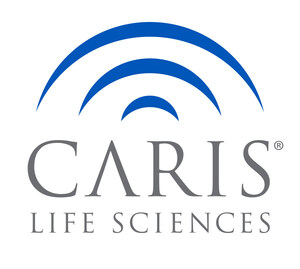Caris Life Sciences Demonstrates Clinical Utility of Tumor Profiling by Identifying Molecular Differences and Additional Therapeutic Options for Hepatocellular Carcinoma
Study Using Caris Molecular Intelligence's Multiplatform Profiling Service Highlighted in Plenary Session at Society of Surgical Oncology Symposium
IRVING, Texas, March 27, 2015 /PRNewswire/ -- Caris Life Sciences® today announced the presentation of data from a study in which Caris Molecular Intelligence®, the company's comprehensive tumor profiling service, revealed the molecular differences of hepatocellular carcinoma (HCC), the most common type of liver cancer. The data, presented at the 68th Annual Cancer Symposium of the Society of Surgical Oncology (SSO) in Houston, Texas, helped researchers identify potential therapies, not normally considered, to target molecular subtypes of HCC, a disease for which treatment options have been extremely limited.
The study titled, "Comprehensive multiplatform biomarker analysis of 313 hepatocellular carcinomas identifies potential novel therapeutic options," was presented today during the Plenary II session at the SSO symposium. Investigators utilized Caris Molecular Intelligence's multi-platform approach, which included gene sequencing (Sanger and next-generation sequencing [NGS]), protein expression analysis (immunohistochemistry [IHC]), and gene copy number analysis (chromogenic or fluorescence in situ hybridization [CISH or FISH]). The investigators examined tumor samples from a large cohort of patients with liver cancer to describe molecular patterns and associations and to identify potential therapeutic targets for this disease.
"Patients with HCC have limited therapeutic options and there is little guidance for clinicians when weighing the next therapeutic steps for sorafenib-refractory disease," commented lead investigator Celina Ang, M.D., Assistant Professor of Medicine in the Department of Hematology and Medical Oncology at the Icahn School of Medicine at Mount Sinai Hospital in New York, N.Y. "This data demonstrates how molecular profiling can reveal potential actionable targets in HCC to provide additional treatment options for patients."
Study Highlights
Using Caris Molecular Intelligence, the researchers conducted a retrospective review of HCC molecular profiling data from 313 individual patient specimens. They reported that the tumor suppressor gene p53 (TP53) was mutated in 28% of samples; other frequently mutated genes included the catenin (cadherin-associated protein) beta 1 (CTNNB1; 23%), and BRCA2 (20%). The TP53-mutated samples exhibited significantly higher expression of topoisomerase 2A (TOPO2A), thymidylate synthase (TS) and ribonucleotide reductase M1 (RRM1), implying high rates of tumor growth and DNA synthesis. Despite the lack of FDA-approved therapies that specifically target TP53, these findings suggest that anthracyclines, fluoropyrimidines (5-FU), and gemcitabine might benefit patients with TP53 mutated liver cancer.
Dr. Ang remarked that CTNNB1 is one of the most frequently mutated genes in liver cancer. This finding suggests that patients harboring CTNNB1 mutations may benefit from agents that target the WNT signaling pathway (i.e., where CTNNB1 resides). In addition, CTNNB1-mutated tumors showed significantly higher expression of the secreted-protein-acidic-and-rich-in-cysteine (SPARC) and androgen receptor (AR) than non-CTNNB1-mutated liver cancers, suggesting combination therapies that could be tested in future clinical trials.
More than half (52%) of the samples showed high expression levels of the programmed cell death protein 1 (PD-1), and 80% showed low expression levels of TS. Metastatic liver cancers (N=105) exhibited significantly higher expression of PD-1 and low TS than primary liver cancers (N=209), suggesting the potential utility of anti-PD-1 immunotherapy in patients with metastatic liver cancer. The investigators also observed amplification of the epidermal growth factor receptor (EGFR) in 10% of patients, suggesting that these individuals might benefit from tyrosine kinase inhibitors (TKIs) that specifically target EGFR.
"Our observations of the molecular structure of hepatocellular carcinoma are generally consistent with the literature, showing few gene mutations and more protein alterations in these patients. Therefore, a multiple technology approach to assess biomarkers should be considered, as a single technology approach, such as Next-Generation Sequencing only, may provide limited data to the treating oncologist," stated Sandeep K. Reddy, M.D., Chief Medical Officer at Caris Life Sciences. "The data also suggests that TKIs, PD-1 and the PI3 kinase pathway inhibitors may benefit selected patients with liver cancer. We hope to see these findings validated in research that generates outcomes data for such targeted therapies."
About Caris Life Sciences® and Caris Molecular Intelligence®
Caris Life Sciences® is a leading biotechnology company focused on fulfilling the promise of precision medicine through quality and innovation. Caris Molecular Intelligence®, one of the industry's leading tumor profiling services with more than 70,000 patients profiled, provides oncologists with the most potentially clinically actionable treatment options available to personalize cancer care today. Using a variety of advanced profiling technologies to assess relevant biological changes in each patient's tumor, Caris Molecular Intelligence connects biomarker data generated from a tumor with biomarker-drug associations supported by evidence in the relevant clinical literature. The company is also developing Carisome® TOP™ technology, a revolutionary and proprietary blood-based profiling platform for diagnosis, prognosis, and theranosis of cancer and other complex diseases. Headquartered in Irving, Texas, Caris Life Sciences offers services throughout Europe, the U.S., Australia and other international markets. To learn more, please visit www.CarisLifeSciences.com.
SOURCE Caris Life Sciences
Related Links
WANT YOUR COMPANY'S NEWS FEATURED ON PRNEWSWIRE.COM?
Newsrooms &
Influencers
Digital Media
Outlets
Journalists
Opted In





Share this article